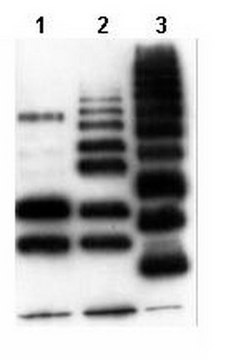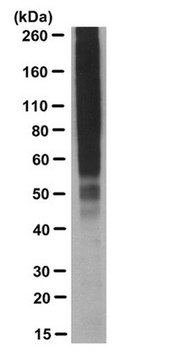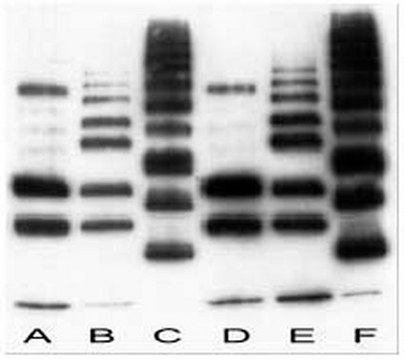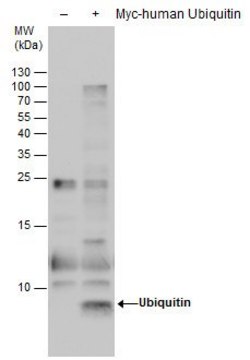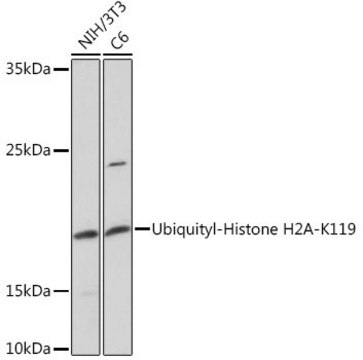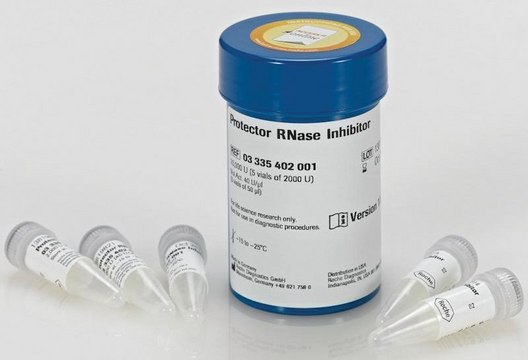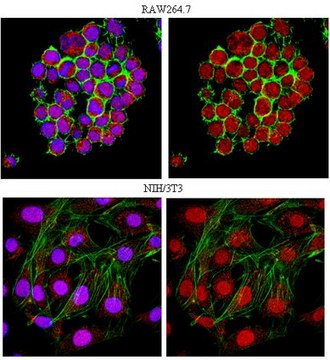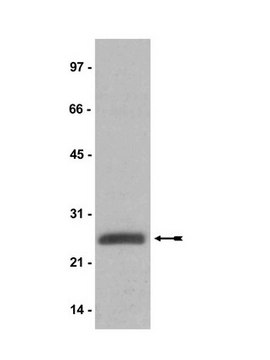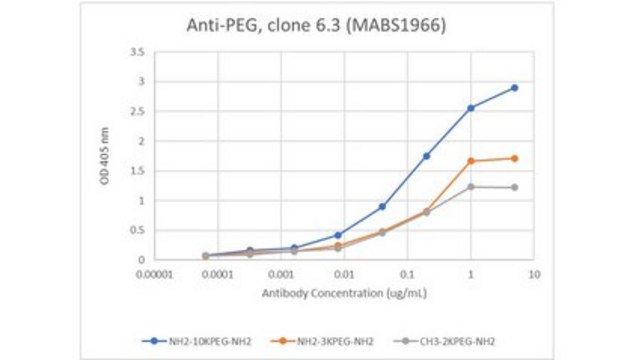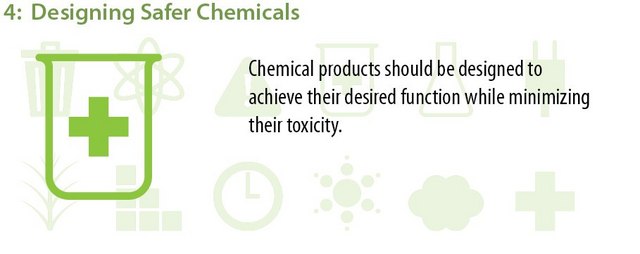General description
We are committed to bringing you greener alternative products, which adhere to one or more of The 12 Principles of Green Chemistry.This antibody is Preservative-free, produced without the harm or sacrifice of animals and exceptionally stable to allow for ambient shipping and storage if needed and thus aligns with "Waste Prevention", "Designing Safer Chemicals" and "Design for Energy Efficiency".
Click here for more information.
ZooMAb® antibodies represent an entirely new generation of recombinant monoclonal antibodies. Each ZooMAb® antibody is manufactured using our proprietary recombinant expression system, purified to homogeneity, and precisely dispensed to produce robust and highly reproducible lot-to-lot consistency. Only top-performing clones are released for use by researchers. Each antibody is validated for high specificity and affinity across multiple applications, including its most commonly used application. ZooMAb® antibodies are reliably available and ready to ship when you need them.
Specificity
Clone 8B21 is a ZooMAb® Rabbit recombinant monoclonal antibody that specifically detects Histone H2A ubiqutinylated on lysine 119.
Immunogen
KLH-conjugated linear peptide corresponding to 10 amino acids surrounding ubiquityl lysine 119 from the C-terminal region of human Histone H2A.
Application
Quality Control Testing
Evaluated by Western Blotting in HeLa cell acid extract.
Western Blotting Analysis: A 1:10,000 dilution of this antibody detected Ubiquityl-Histone H2A-Lys119 in HeLa cell acid extract.
Tested Applications
Western Blotting Analysis: A 1:10,000 dilution from a representative lot detected Ubiquityl-Histone H2A-Lys119 in acid exacts of Balb3T3/A31, HL-60, and Rat2 cells.
Peptide Inhibition Assay: Target band detection in HeLa cell acid extract was prevented by preblocking of a representative lot with the immunogen Ubiquityl-Histone H2A-Lys119 peptide.
Immunohistochemistry (Paraffin) Analysis: A 1:1,000 dilution from a representative lot detected Ubiquityl-Histone H2A-Lys119 in human testis tissue sections.
Immunocytochemistry Analysis: A 1:100 dilution from a representative lot detected Ubiquityl-Histone H2A-Lys119 in HeLa cells.
Flow Cytometry Analysis: 1 µg from a representative lot detected Ubiquityl-Histone H2A-Lys119 in one million NIH3T3 cells.
Note: Actual optimal working dilutions must be determined by end user as specimens, and experimental conditions may vary with the end user.
Target description
Histone H2A type 1-A (UniProt: Q96QV6; also known as H2A-clustered histone 1, Histone H2A/r) is encoded by the H2AC1 (also known as H2AFR, HIST1H2AA) gene (Gene ID: 221613) in human. Histones are highly conserved basic nuclear proteins that are responsible for the nucleosome structure of chromatin in eukaryotes. They play a central role in transcription regulation, DNA repair, DNA replication and chromosomal stability. DNA accessibility is regulated via a complex set of post-translational modifications of histones, also called histone code, and nucleosome remodeling. Two molecules of each of the four core histones (H2A, H2B, H3, and H4) form an octamer, around which DNA is wrapped in repeating units, called nucleosomes, which limits DNA accessibility to the cellular machineries that require DNA as a template. Histones are modified post-translationally by acetylation, phosphorylation, methylation, and ubiquitination and these modifications regulate DNA transcription, repair, recombination, and replication. Ubiquitylation usually targets the substrate for degradation, although histones H2A and H2B are actually stabilized by a single ubiquitin conjugation. Histone ubiquitination has been correlated with DNA repair and transcription, cellular differentiation, cell cycle regulation, spermatogenesis, protein trafficking, and response to stress. Histone H2A is involved in the structure of chromatin in eukaryotic cells. It features a main globular domain and a long N-terminal tail H2A. Monoubiquitination of lysine 119 (H2AK119Ub) by RING1, TRIM37 and RNF2/RING2 complex, a highly conserved modification, gives a specific tag for epigenetic transcriptional repression and participates in X chromosome inactivation of female mammals. It is involved in the initiation of both imprinted and random X inactivation. Ubiquitinated H2A is reported to be enriched in inactive X chromosome chromatin. H2AK119Ub is also reported to play a role in spermatogenesis and may promote transformation of cells in a number of breast cancers. This ZooMAb® recombinant monoclonal antibody, generated by our propriety technology, offers significantly enhanced specificity, affinity, reproducibility, and stability over conventional monoclonals. (Ref.: Barbour, H., et al. (2020). Nat. Commun. 11; Article 5947; Bhatnagar, S., et al. (2014). Nature. 516(7529); 116-120).
Physical form
Purified recombinant rabbit monoclonal antibody IgG, lyophilized in PBS, 5% Trehalose, normal appearance a coarse or translucent resin. The PBS/trehalose components in the ZooMAb formulation can have the appearance of a semi-solid (bead like gel) after lyophilization. This is a normal phenomenon. Please follow the recommended reconstitution procedure in the data sheet to dissolve the semi-solid, bead-like, gel-appearing material. The resulting antibody solution is completely stable and functional as proven by full functional testing. Contains no biocide or preservatives, such as azide, or any animal by-products. Larger pack sizes provided as multiples of 25 µL.
Reconstitution
0.3 mg/mL after reconstitution at 25 µL per vial. Please refer to guidance on suggested starting dilutions and/or titers per application and sample type.
Storage and Stability
Recommend storage of lyophilized product at 2-8°C; Before reconstitution, micro-centrifuge vials briefly to spin down material to bottom of the vial; Reconstitute each vial by adding 25 µL of filtered lab grade water or PBS; Reconstituted antibodies can be stored at 2-8°C, or -20°C for long term storage. Avoid repeated freeze-thaws.
Legal Information
ZooMAb is a registered trademark of Merck KGaA, Darmstadt, Germany
Disclaimer
Unless otherwise stated in our catalog or other company documentation accompanying the product(s), our products are intended for research use only and are not to be used for any other purpose, which includes but is not limited to, unauthorized commercial uses, in vitro diagnostic uses, ex vivo or in vivo therapeutic uses or any type of consumption or application to humans or animals.

